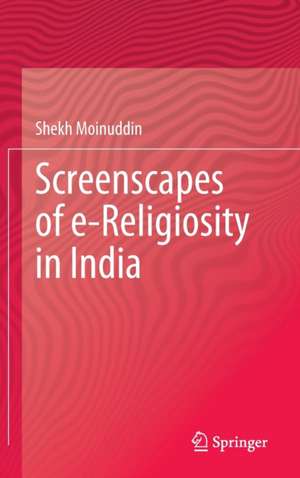Screenscapes of e-Religiosity in India
Autor Shekh Moinuddinen Limba Engleză Hardback – 4 apr 2023
The book covers contemporary digital discourses of e-religiosity in a sense of screenscapes that often found pivot indaily discussions across social media platforms. Screenscapes are considered as mediated technologies when contents can be accessed from different social media apps to construct or deconstruct their views, narratives, discourses, ideas, emotions, and perceptions around religious images in day-to-day activities, practices, rituals, customs, traditions, faiths and beliefs. The used illustrations exclusively map Indian religious gestures, identities, values, and rituals in digital-spatial contexts. The book discusses seven major questions and argues the same across the chapters in varied representations and interpretations: How and to what extent has the meaning of religiosity changed in the digital age? What are the dimensions of e-religiosity in India? How are digital devices (re)shaping religiosity in terms of e-religiosity? How and to what extent digital devices are negotiating with social and cultural lives? What is digital spatiality? How and to what extent does social media influence religiosity?
Preț: 781.94 lei
Preț vechi: 953.58 lei
-18% Nou
Puncte Express: 1173
Preț estimativ în valută:
149.63€ • 160.00$ • 124.75£
149.63€ • 160.00$ • 124.75£
Carte tipărită la comandă
Livrare economică 18 aprilie-02 mai
Preluare comenzi: 021 569.72.76
Specificații
ISBN-13: 9783031288500
ISBN-10: 3031288505
Pagini: 163
Ilustrații: XXIII, 163 p. 49 illus., 46 illus. in color.
Dimensiuni: 155 x 235 mm
Greutate: 0.44 kg
Ediția:2023
Editura: Springer International Publishing
Colecția Springer
Locul publicării:Cham, Switzerland
ISBN-10: 3031288505
Pagini: 163
Ilustrații: XXIII, 163 p. 49 illus., 46 illus. in color.
Dimensiuni: 155 x 235 mm
Greutate: 0.44 kg
Ediția:2023
Editura: Springer International Publishing
Colecția Springer
Locul publicării:Cham, Switzerland
Cuprins
Chapter 1. Remapping The Religion.- Chapter 2. Contours of Mediatized E- Religiosity.- Chapter 3. Digital Facets of E- Religiosity.- Chapter 4. Spatial Mapping of Screenscapes.- Chapter 5. Digital Negotiation of Religiosity In India.- Chapter 6. Spaces Of Screenscapes In India.- Chapter 7. Contours of Image Politics In India.- Chapter 8. Postscript: Screenscapes of E-Religiosity.
Notă biografică
Dr. Shekh Moinuddin is media geographer and author of five books Media Space and Gender Construction (2010), Mapping Media (2015), Mediascape and the State: A Geographical Interpretations of Image Politics in UP, India (2017), The Political Twittersphere in India (2019), Digital Shutdowns and Social Media: Spatiality, Political Economy and Internet Shutdowns in India (2021). His research areas include media geography, social media, digital spatiality, cultural mappings, image-politics, digital shutdown, political economy of digital gadgets, digital loneliness, platform democracy, and e-religiosity in India.
Textul de pe ultima copertă
This book deals with three different subjects: geography, social media and religion equally to discuss e-religiosity in terms of screenscapes that shaped digital socialization processes wherein the role of digital devices in general and smartphones in particular are considered crucial and critical. The spatial dimension is the primary foundation of the book wherein both space and place are discussed in digital manifestations in spatial sense. Religiosity is discussed variably in a sense of spirituality, social theories, religions and images. The book uses some illustrations to understand image politics. Image politics is quintessential in the age of digital technologies when production and reproduction of images are not restricted to business only; rather it attracts politics too and politicians often use the same to make political scores against opponents.
The book covers contemporary digital discourses of e-religiosity in a sense of screenscapes that often found pivotin daily discussions across social media platforms. Screenscapes are considered as mediated technologies when contents can be accessed from different social media apps to construct or deconstruct their views, narratives, discourses, ideas, emotions, and perceptions around religious images in day-to-day activities, practices, rituals, customs, traditions, faiths and beliefs. The used illustrations exclusively map Indian religious gestures, identities, values, and rituals in digital-spatial contexts.
The book discusses seven major questions and argues the same across the chapters in varied representations and interpretations: How and to what extent has the meaning of religiosity changed in the digital age? What are the dimensions of e-religiosity in India? How are digital devices (re)shaping religiosity in terms of e-religiosity? How and to what extent digital devices are negotiating with social and cultural lives? What is digital spatiality? How and to what extent does social media influence religiosity?
The book covers contemporary digital discourses of e-religiosity in a sense of screenscapes that often found pivotin daily discussions across social media platforms. Screenscapes are considered as mediated technologies when contents can be accessed from different social media apps to construct or deconstruct their views, narratives, discourses, ideas, emotions, and perceptions around religious images in day-to-day activities, practices, rituals, customs, traditions, faiths and beliefs. The used illustrations exclusively map Indian religious gestures, identities, values, and rituals in digital-spatial contexts.
The book discusses seven major questions and argues the same across the chapters in varied representations and interpretations: How and to what extent has the meaning of religiosity changed in the digital age? What are the dimensions of e-religiosity in India? How are digital devices (re)shaping religiosity in terms of e-religiosity? How and to what extent digital devices are negotiating with social and cultural lives? What is digital spatiality? How and to what extent does social media influence religiosity?
Caracteristici
Helps to understand e-religiosity easily Explains the spatial dimensions of digital gadgets in terms of space and place Is easy to conceptualize the extent and pattern of e-religiosity through digital gadgets
